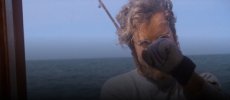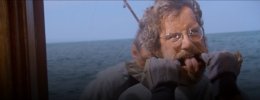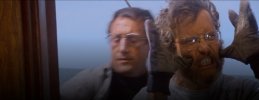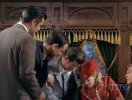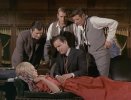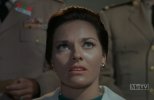Post-58th Anniversary Viewing
The Time Tunnel
"End of the World"
Originally aired September 23, 1966
Edited Frndly/IMDb said:
In a 1910 mining town, Tony and Doug try to rescue 200 miners trapped by a cave-in. Nobody wants to help, believing that the world will end in a couple of hours when Halley's Comet crashes into the Earth.
May 21, 1910: Doug and Tony land in different parts of the Emperor Mine as it's being evacuated for a collapse that's trapped 200 people. Doug confirms that Tony's trapped but is able to get out himself, so he goes to the mine supervisor, Henderson (Paul Fix), only to find him despondently unconcerned with rescuing his men because of a massive fireball in the sky that looks absolutely nothing like Halley's Comet. Back at Tic-Toc, Ann gets a fix on Doug as he's going back to dig Tony out himself. After he succeeds, the two of them confront Henderson to learn that he believes the world's about to end...news that broke so recently that the men trapped in the shaft, led by Blaine (Paul Carr), whom Tony takes a call from, don't know about it. The guys try to tell Henderson that the comet's going to miss Earth. (IMDb informs me that it missed Earth by 14 million miles, so not exactly the close call that's being portrayed here. Yeah, I don't think we need to fret over the effects of time travel on Doug and Tony's digestive systems....)
In 1968, by which point people really should know better than all of this, Kirk becomes concerned that the comet they're fixed on might affect the complex. In 1910, Henderson shows the guys a newspaper headline about local astronomy professor Ainsley having predicted that the comet will hit Earth. Doug decides to go confront Ainsley, hoping that TT will be monitoring and send him modern instruments to convince the professor. Tony tries knocking on doors to round up some help for the miners, but after turning up nobody, goes to the local sheriff (James Westerfield), who's also a doomsday believer and tells him how panic over the prediction has spread across the state.
Doug finds himself hitting a wall with Ainsley (Gregory Morton), but gets to work on equations that he hopes will support his argument. While the TT crew are planning to send him a radarscope to help, a technician named Jerry (Sam Groom) theorizes that their probes could interact with the magnetic field of the comet in a dangerous manner. Tony finds a mob of people holding torches while watching the comet, none of whom care to help; but the sheriff volunteers, and the two of them find Henderson already in the mine, having decided to keep himself busy while he waits for the end...but he causes a new cave-in that falls squarely on top of him.
What exactly are the torches for? They wouldn't help them to see the comet, but if it's bright enough to be seen through all that light pollution, they wouldn't need the torches to see anything. I guess the torches are just their "ignorant villagers" badges. Or maybe the villagers were on their way to engage in some looting and pillaging, which is what the TT crew watch happening far and wide. When they try to send the radarscope, it combusts. Jerry later finds that the comet is having a strange effect on the TT controls. Back in 1910, Doug only manages to prove Ainsley's calculations that they're inside 2-1/2 hours of impact, but postulates that there could be a dark mass in space that will draw the comet away from Earth. In the mine, while Blaine tries to convince his men not to give up--assuming that crews are working to get them out--the sheriff works to free Tony from the rubble that he's pinned under.
Ainsley just happens to be in possession of one of the handful of those newfangled radiometers in existence, so they wire it to the telescope, via which Doug soon finds a section of sky containing no reflective object that nevertheless generates intense radiant energy. This completely changes the equation, so, the phone lines being unmanned, they go find the torch mob, to whom Ainsley retracts his prediction. But being short of a paid spokesman, they're silently doubtful until the scientists successfully predict when the fiery comet's tail will vanish to the second.
At TT, the magnetic attraction through the tunnel from locking in on the comet causes the instruments to go wild, and eventually overload. As the complex is being evacuated, the tunnel starts sucking the air out of the control room, and Jerry into it. They manage to shut down the tunnel and pull him away, but his heart stops from electrical shock. Lacking immediately available resuscitation equipment, Ann rigs some wires from the console to give Jerry's heart a jump-start. In the aftermath, Dr. Swain questions the future of the project given the extreme danger of the forces they're dealing with, against Ann's objections, while Kirk plays the voice of reason and talks him down.

In 1910, a desperate Blaine puts in another call, and Tony, unable to offer a rescue ETA, is about to reluctantly break the bad news to him when Doug rushes in to announce the arrival of the torch mob, who can be heard murmuring outside. Doug and Tony then disappear before the sheriff's eyes.
I read that some scenes from a longer pilot version of the premiere were repurposed for other episodes, and I strongly suspect that our next bit of business is one of them, especially as it takes place on the same exterior location as was used in the premiere. Tony and Doug are separated, with Tony appearing in the desert outside the complex to be confronted by guards who don't know him, including a younger-looking Jiggs. The 1968 TT crew, monitoring from a now fully manned and running control room, determine that Tony's ten years in the past, which is three years before he started at Tic-Toc. Although Tony realizes that he's in the wrong time, when a more youthfully bowtie-sporting Doug drives by, apparently leaving the complex, Tony becomes dramatically desperate for Doug to confirm who he is, running after his car as he drives off. The TT crew pull Tony out before the guards can fire on him.
Exterior hygiene resetting is confirmed, as 1910 Tony was sooty enough to sing "Chim Chim Cher-ee".
Not only did this episode feature two actors who appeared in the same episode of
Trek, but it originally aired the very next night!
The Invaders
"The Mutation"
Originally aired January 24, 1967
IMDb said:
In a border town, David Vincent meets a stripper who claims to have seen something strange in the desert.
David is driven into the desert by a pair of locals (Roberto Contreras and Pepe Callahan) who claim to have seen strange lights, but begins to suspect a con. When they get out, he's TV Fu'ed, robbed of his valuables, and left to die. As David stumbles under the blazing sun, he comes upon a wavy-pictured view of one of
their craft, grounded as uniformed thems work outside.
The QM Narrator said:
Three weeks since the report of a crash and strange, glowing lights had brought reporters, the Air Force, and David Vincent to the border town of Rosario. Betrayed by his own kind and left to die under a blazing sun, he retains a vision of a ship launched by another kind, under another sun. Now, the Air Force and reporters have gone. David Vincent remains to begin the search again.
After we return from the post-credits break, we see David checking out of a clinic in town, and learn that a UFO-jaded Air Force Intelligence officer named Fellows (Lin McCarthy) has been assigned to stay behind until Vincent leaves; while the local sheriff, Cobbs (William Stevens), is eager for David to be on his way since his Jeep was recovered and the thieves caught. A pair of young locals try to run David down in the street, but he evades them with the help of a push from a man named Evans (Edward Andrews), who says that he's a reporter and has a contact who claims to have seen the same saucer that David did. Evans takes David to the club where the contact, Vikki (
Tonight's Special Guest Star--
wait'll the Chicago school board learns about this!), works as a striptease artist. She reluctantly goes back over what she saw while downplaying the incident, including that the craft couldn't take off, which jibes with David's perception that the saucer he saw was under repair; and agrees to take David to the site for money that Evans puts up. But we see Evans make a rendezvous with Vikki in her dressing room afterward, where he uses the apparently multipurpose hand-disc device to report to
them (Roy Jenson in this case) how he plans to deliver Vincent.
After David and Vikki depart for the desert, Fellows, who's been watching developments from afar, questions Evans about what Vincent's up to. At a stop for eats, David helps the young son (Tony Davis) of the proprietor (Tina Menard) when the boy accidentally catches fire. As David's treating his own burns, he angrily questions Vikki about how she just sat and watched. The aliens monitor as David's Jeep approaches, but when they stop, Vikki, having had a change of heart, tries to turn David away. He continues far enough to see the ship before the aliens disintegrate his vehicle. David and Vikki flee into Vasquez Rocks while the aliens pursue on foot. Vikki, no longer pretending not to be one of them, explains that she's like her late, rebellious father in being different from the others--capable of feeling compassion. One of the invaders finds them and gets into a brawl on the rocks, which ends when the alien takes a fall and disintegrates in a red glow--the first time David witnesses what happens to them when they die on Earth, as he's told by Vikki.
Fellows, who's been ordered to return to Washington, questions Vikki's manager (Val Avery) to learn that her background credentials didn't check out. Elsewhere, David and Vikki take shelter at the ranch house of Miguel (Rodolfo Hoyos) and his wife Luz (Argentina Brunetti). As David's about to leave in a borrowed truck to find Fellows, she tells him that she's come to enjoy caring for him, though she still won't betray her people by letting herself be taken into custody. After he leaves, she uses her own disc to tell
them where he's headed--the nearest town with a phone, from which he calls Fellows. Evans is eavesdropping on another line as David outs him.
An invader party seizes the ranch house, tucks the owners away, and waits for David to return, while Vikki unsuccessfully argues that they not kill him for the reasons already outlined in the premiere. When David arrives, she runs out to warn him, only to be shot in the back by the alien leader with a ray gun, which results in her disintegration. David then has a shoot-out with all three aliens, taking each out in turn with a rifle, each disintegrating after he falls. Just as the battle has ended, David sees the saucer lifting off in the distance.
By the time Fellows arrives in the Epilog, David has nothing to show him--no saucer and no aliens. The couple who own the ranch give David a little credibility by testifying how he helped them against strange men who forced their way into the house. David assures Fellows that he won't find Evans back in town, and Fellows expresses increasing uncertainty about David's situation.
The QM Narrator said:
For a moment, in the desert south of Rosario, a man and woman came together across a void of space and time. Two people, star-crossed from alien worlds. In the months to come, David Vincent will remember that moment.
Is he planning to rebuild her with steam driven parts?
Which one, Audra or Victoria?
No, but my brain is now doing so.


I think you're talking about the Earth, Wind, and Fire song, but I meant Bad Company. How do you like that one?
I was comparing the two qualitatively--if the EWF song is filet mignon, the BC song is a fast-food cheeseburger.
The Six-Million Silver Dollar Woman.
Whipping out the inflation calculator, more like
The One Million Silver Dollar Woman, if we're rounding down from 1.19.
That would have been a cool
Wild Wild West crossover. I wonder how the timelines line up.

TBV is reportedly a bit later than the Grant era of WWW, between 1884 and 1888.














